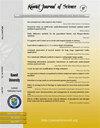阿尔及利亚多产地杏品种形态生化评价及生物多样性评价
IF 1.1
4区 综合性期刊
Q3 MULTIDISCIPLINARY SCIENCES
引用次数: 0
摘要
水果质量是分销商、生产商和消费者都非常关心的问题,它主要是由营养和味道相关的方面决定的。杏树等栽培李属植物的发育受到多种因素的影响,这些因素的干扰不仅会导致产量下降,还会导致遗传多样性的丧失。本研究旨在通过形态分析(包括定性和定量性状)、生化分析(包括pH、总可溶性固形物(TSS)和可滴定酸度(TA))和蛋白质分析(利用十二烷基硫酸钠聚丙烯酰胺凝胶电泳(SDS-PAGE)凝胶分析),研究杏果实品质的遗传多样性和相关性状。结果表明,在形态生化和蛋白质分析方面,杏品种间存在显著差异。形态分析表明,Boufarik、Khad Romia、Lokmi、Pavi和Bish等品种果实中等大小,而在颜色上,Tounsi、Polonais、Rosi和Louzi是突出的红色品种。中等硬度方面,tousi、Boufarik和Khad Romia表现出色,而Boulachourand和Louzi品种的主要肤色为浅橙色。另一方面,生化分析表明,TSS高于12°Brix的品种果实品质较好,而Pavi和Polonais等品种的TSS低于12°Brix。Lokmi品种的TA值在0.90%以下,Tounsi、Bedai、Khad Romia、Monte、Bensermoukh、Boulachour、Rosi、Lokmi Louzi和wild杏的pH值在3以上,是口感品质较高的品种。SDS-PAGE分析通过显示不同的蛋白质条带,突出了品种间的多样性,可以作为生物化学标记。在337 kDa、130 kDa和72 kDa之间以及59 kDa和47 kDa之间观察到变化。结果表明,这些品种具有良好的味觉品质,适合大规模商业使用,并在育种计划中具有良好的前景。本文章由计算机程序翻译,如有差异,请以英文原文为准。
Morpho-biochemical evaluation and biodiversity assessment of multi-origin apricot cultivars in Algeria
Fruit quality is a major concern for distributors, producers, and consumers alike, and it is mostly determined by facets related to nutrients and taste. The development of cultivated Prunus species, such as apricot trees, is influenced by multiple factors in which the disruptions can lead not only to reduced production but also to a loss of genetic diversity. This study was aimed at investigating the genetic diversity and analysing the traits related to apricot's fruit quality through morphological characterization, including both qualitative and quantitative traits, biochemical analysis, including pH, total soluble solids (TSS), and titratable acidity (TA), and protein analysis by using sodium dodecyl sulfate polyacrylamide gel electrophoresis (SDS-PAGE) gel. The results revealed significant variability among the apricot cultivars for morpho-biochemical as well as protein analysis. Morphological analysis revealed that cultivars such as Boufarik, Khad Romia, Lokmi, Pavi, and Bish yielded medium-sized fruits, while in terms of red hue in the overcolour, cultivars namely Tounsi, Polonais, Rosi, and Louzi were the prominent ones. In terms of medium firmness, Tounsi, Boufarik, and Khad Romia were remarkable, while a predominant skin colour of light orange was observed in Boulachourand and Louzi cultivars. On the other hand, biochemical analysis showed that the cultivars with TSS exceeding exhibited better fruit quality, while the cultivars such as Pavi and Polonais yielded lower TSS than 12°Brix. Similarly, the Lokmi cultivar recorded TA below 0.90 %, and Tounsi, Bedai, Khad Romia, Monte, Bensermoukh, Boulachour, Rosi, Lokmi Louzi, and wild apricot had pH above 3, marking them as the cultivars with high taste quality. SDS-PAGE analysis highlighted the diversity among cultivars by displaying distinct protein bands, which can be useful as a biochemical marker. Variations were observed at 337 kDa, between 130 kDa and 72 kDa, and at 59 kDa and 47 kDa. The results obtained qualify these varieties for large-scale commercial use due to their gustatory qualities and identify them as promising candidates in breeding programs.
求助全文
通过发布文献求助,成功后即可免费获取论文全文。
去求助
来源期刊

Kuwait Journal of Science
MULTIDISCIPLINARY SCIENCES-
CiteScore
1.60
自引率
28.60%
发文量
132
期刊介绍:
Kuwait Journal of Science (KJS) is indexed and abstracted by major publishing houses such as Chemical Abstract, Science Citation Index, Current contents, Mathematics Abstract, Micribiological Abstracts etc. KJS publishes peer-review articles in various fields of Science including Mathematics, Computer Science, Physics, Statistics, Biology, Chemistry and Earth & Environmental Sciences. In addition, it also aims to bring the results of scientific research carried out under a variety of intellectual traditions and organizations to the attention of specialized scholarly readership. As such, the publisher expects the submission of original manuscripts which contain analysis and solutions about important theoretical, empirical and normative issues.
 求助内容:
求助内容: 应助结果提醒方式:
应助结果提醒方式:


